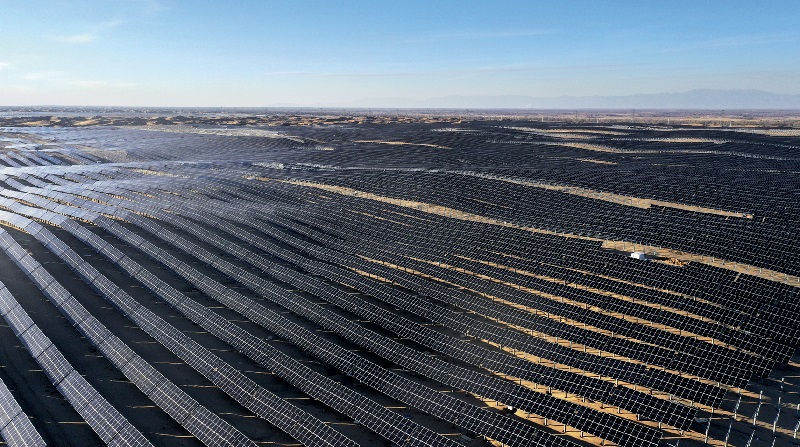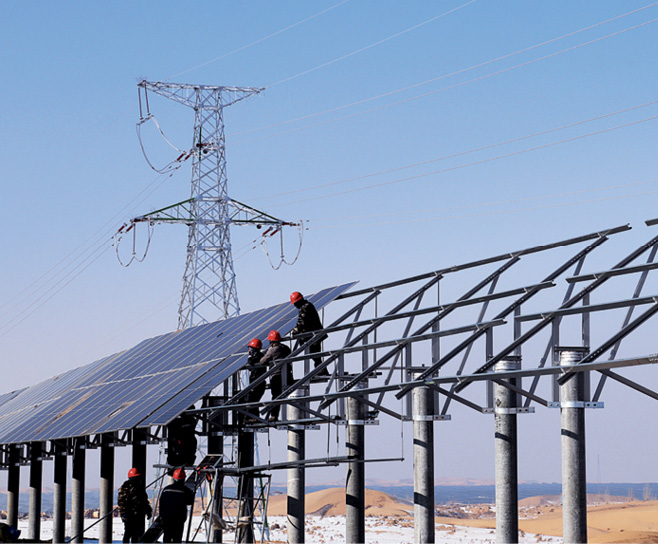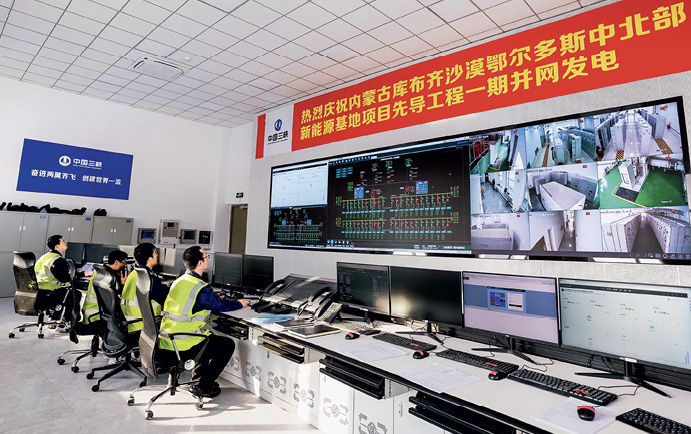
An aerial photograph shows the first phase of the Kubuqi base’s pilot project. Photo courtesy of China Three Gorges Corporation

Dalad Banner in Ordos, Inner Mongolia Autonomous Region in north China, is characterized by a seemingly endless stretch of barren land. Kubuqi, China’s seventh-largest desert, occupies nearly one-third of the county-equivalent banner’s land area. How to transform and utilize this barren land has been a focus of the area’s development.
Thanks to abundant daylight and wind resources in the desert, wind and solar power generation has emerged as an important way to reap economic and ecological benefits from the desert.
Now, the desert features a new vast expanse of blue. On December 29, 2023, the first pilot project of China Three Gorges’ (CTG) wind and photovoltaic base in central and north Kubuqi was completed and connected to the grid, with a capacity of 1 GW.
The project comprises 350,000 tall concrete pillars supporting millions of photovoltaic panels, covering more than 30,000 mu (2,000 hectares) of desert, stretching as far as the eye can see.
These are only a small part of the total planned capacity of the base, which is 12 GW, including 8 GW of photovoltaics and 4 gw of wind power. Once fully completed, Dalad Banner’s new energy production capacity will multiply.

Workers are installing photovoltaic panels in Dalad Banner, Ordos, Inner Mongolia Autonomous Region, on December 25, 2023.

A Massive Project
The base is an outcome of a plan released in February 2022 by the National Development and Reform Commission (NDRC) and the National Energy Administration to develop large-scale wind and solar power generation bases in the country’s desert areas.
In a bid to meet the country’s carbon peak and carbon neutrality goals, the NDRC proposed to plan and construct bases mostly in the Kubuqi, Ulan Buh, Tengger, and Badain Jaran deserts. According to the plan, the bases will have a total installed capacity of approximately 455 gw by 2030.
The plan discourages construction of very small projects, believing that the large scale of the bases can quickly improve the share of clean energy in China’s energy production. It also requires existing coal-burning power plants around these bases to be upgraded for higher efficiency and used as supportive power source.
As a leading player in clean energy development in China, CTG was among the first to respond to the call and joined hands with a local company to invest in and construct the Kubuqi base. The project, after completion, will save 6 million tonnes of standard coal and reduce carbon dioxide emissions by about 16 million tonnes every year.
“I feel very honored to be able to participate in the construction of a new energy base of this size,” said Bei Yaoping, deputy general manager of Inner Mongolia Three Gorges Mengneng Energy Co., Ltd. (TGME), a joint venture of CTG with Inner Mongolia’s leading energy company Mengneng Group.
With 13 years of experience in solar power construction, Bei has personally witnessed the accelerated development of China’s clean energy construction. “Initially, I was doing projects of 10 to 20 mw,” he said.
Despite the various challenges such as harsh natural conditions, Bei and his colleagues are full of enthusiasm. The first 1-gw pilot of the project started construction in April 2023 and was connected to the grid for power generation by the end of the year, creating a new record in CTG in terms of construction speed. During the busiest days, nearly 200 bulldozers were used to carry out land levelling operations at the same time, and thousands of people worked in the evening when the weather is cooler.
The base is designed to include not only wind and photovoltaic power capacity, but also a supporting capacity of approximately 4 gw of coal power and energy storage capacity of approximately 3 to 5 gwh, a typical combination for such bases. This helps to overcome the major shortcoming of wind and photovoltaic power generation, which is instability. In peak hours of clean energy generation, surplus output is saved in storage facilities, which is then used in hours of short supply with the support of coal-fired power, thus maintaining stable output of the base.
According to Na Guiting, vice chairman of TGME, the combination based on careful calculation will ensure the base’s stable power output of 8 GW. Over 90 percent of the generated clean energy will be utilized, and the proportion of clean energy in the base’s output will be more than 50 percent.
The generated power will be transmitted to the Beijing-Tianjin-Hebei region through an ultra-high voltage power transmission project to be built. Currently, power from the pilot project is sent to the local grid. After the whole project is completed, it will be able to deliver 44 billion kwh of clean electricity annually.
On the same day when the first pilot project was connected to the grid, CTG announced the start of the subsequent construction of the base. According to its plan, the entire project will be completed and connected to the grid by the end of 2025.
Progress has also been made in other big base projects. In Inner Mongolia, for example, the other three projects with similar capacity, including one in the southern part of Kubuqi Desert, have started their pilot projects, which are expected to be connected to the grid by the end of this year.

Workers are monitoring operations of the full capacity grid connected power generation at phase one of the Kubuqi base’s pilot project. Photo courtesy of China Three Gorges Corporation
Boosting Local Development
Though most of these wind and photovoltaic bases are designed to send power to cities far away, they also bring tangible ecological and economic benefits for local development.
According to Na, control of desertification is an important goal of the project. The photovoltaic panels and the pillars supporting them help to prevent sand dunes from moving and reduce water evaporation from the soil below. In addition, a three-level desertification prevention system is applied, formed by forests on the periphery of the base, windbreak forests along internal roads, and economic forests in photovoltaic fields.
Through experiments, CTG has found a way to make the sandy soil suitable for growing plants. Silt from the banks of the Yellow River nearby is added to sand on the surface of the land and mixed with organic fertilizer, and then drained water from nearby coal mines is processed and used for drip irrigation. “By doing this, we make use of the waste water from coal mining, thus saving water, which is precious in the region,” Na said.
With the method, a total of 400 mu (26.67 hectares) of alfalfa has been planted on the base. Na said they will also try planting herbs such as astragalus, licorice and wolfberry. The goal is to improve the soil quality to the extent that no irrigation is required in three years, thus making the project sustainable in the arid area.
The improved soil will make agriculture and animal husbandry under the panels possible, which is economically significant for local farmers and herdsmen. To facilitate operations in the solar farm, pillars taller than those found in earlier farms are used, lifting the panels 2.5 metres above land surface.
Despite the fact that these efforts lead to increased costs for desertification, Na believes it is acceptable and worthwhile. “The combination of new energy and prevention of desertification in the project has made it possible for us to gain both economic and social benefits in a commercially viable manner,” he said.